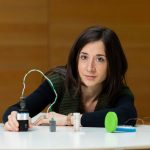Powering IoT sensors from ambient vibrations
Content of the lecture:
Most of the conventional wireless sensor nodes that form the Internet of Things (IoT) are currently battery powered, and routine battery replacement is required that incurs high maintenance costs and negative environmental impact. In the vicinity of the sensor, there is often an abundance of kinetic energy in the form of ambient vibrations that can be converted into electrical power through energy harvesting techniques.
In this talk I will present the three most common transduction mechanisms (piezoelectric, electromagnetic and electrostatic) and I will cover how vibrational energy harvesters (VEHs) can be modelled. Moreover, I will present the challenges of working with real ambient vibrations and how we can increase the bandwidth of VEHs by exploiting nonlinearities or multimodal devices. Finally, I will present a use case where two different IoT sensors (a LoRaWAN sensor node and a BLE one) were powered by the real vibrations of an air compressor.
Teacher: Dr. Valeria Nico
 Dr Valeria Nico is an Associate Professor in the School of Engineering, UL and member of the SFI CONNECT Centre for Future Networks and Telecommunications where she is leading the activities on vibrational energy harvesting. Dr Nico is also part of the first European testbed on wireless sensor nodes based on Energy Harvesting (EnTICe). Her main research goal is to provide an alternative energy source to batteries to power sustainably wireless sensors for Internet of Things (IoT) applications. To date, Dr Nico has published 10 peer-reviewed journal articles, 9 peer-reviewed conference papers and 2 patent applications, one of which on a novel nonlinear vibrational energy harvester. Dr Nico has also taken part in a range of activities to promote STEM disciplines to school children by getting involved in “I am a scientist, get me out of there”, “BT Young Scientist” and “SFI Science Week”.
Dr Valeria Nico is an Associate Professor in the School of Engineering, UL and member of the SFI CONNECT Centre for Future Networks and Telecommunications where she is leading the activities on vibrational energy harvesting. Dr Nico is also part of the first European testbed on wireless sensor nodes based on Energy Harvesting (EnTICe). Her main research goal is to provide an alternative energy source to batteries to power sustainably wireless sensors for Internet of Things (IoT) applications. To date, Dr Nico has published 10 peer-reviewed journal articles, 9 peer-reviewed conference papers and 2 patent applications, one of which on a novel nonlinear vibrational energy harvester. Dr Nico has also taken part in a range of activities to promote STEM disciplines to school children by getting involved in “I am a scientist, get me out of there”, “BT Young Scientist” and “SFI Science Week”.
